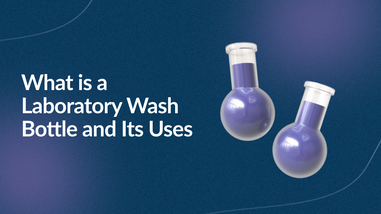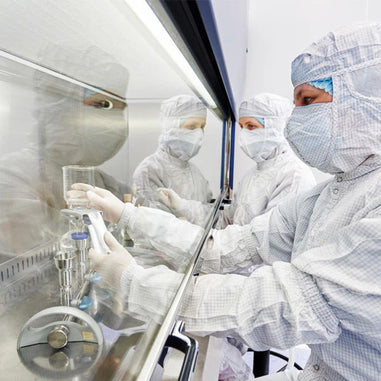- No products in the cart.
Sterilization is the bedrock of experimentation within cellular biology and biomedicine. Without sterilized laboratory instruments, most biomedical laboratories would be incapable of performing any type of work involving living cells in culture. While many labs are comfortable having an informal relationship with sterility, underestimating the impact of having sterile lab instruments is extremely rare. Nonetheless, sterilization is often relegated to junior laboratory personnel as an essential drudge chore, much like cleaning glassware.
A weak instrument sterilization process can lead to even larger financial losses than a total lack of sterilization facilities. When laboratories utilize poorly sterilized equipment, experiments can easily become contaminated, leading to losing money on producing unusable or aberrant results. In some situations, contaminated equipment can contaminate other instruments or pieces of hardware, causing the lab to experience multiple points of experimental failure that can be difficult to isolate and remedy. Avoiding these pitfalls of insufficient sterilization requires viewing sterility with a rigorous and results-driven approach—a practice that many labs could benefit from adopting.
Which Instruments Should Be Sterilized?
Sterilization is extremely important for any laboratory performing cellular culture work to the point where it is not hyperbole to state that all laboratory instruments involved in cell culture must be sterilized. Most labs have an abundance of hardware which is not directly involved in cell culture work even if they do cell culture, however. Importantly, even equipment which is not involved in cell culture can benefit from being sterilized—assuming that the laboratory can handle the cost of sterilization.
For instance, laboratories which routinely perform gene sequencing or PCR may find it a difficult economic proposition to sterilize the pipettors and thermocycler machines which are necessary for performing molecular biology work. Because these pieces of equipment are not involved in culturing cells, the consequences of imperfect sterility are insignificant—or so the rationale goes. Critically, this rationale is incorrect.
While it is true that biological contamination on these instruments will not cause a very expensive cell culture experiment to die off after being exposed to errant microbes, even ex-vivo experiments can have their results disrupted by errant exposure to biological material.
Even for pieces of laboratory hardware which are never exposed directly to any biological material at all, sterilization is an important preventative measure. By sterilizing the interior of a biosafety cabinet, for example, laboratories ensure that the workspace for their experiments cannot be a source of contamination. Similarly, sterilizing glassware ensures that it can be used adjacent to sensitive experiments without fear of disrupting the results.
Not all labs have enough funding to sterilize everything that could benefit, however. Sterilization is expensive as a rule, and so most labs end up prioritizing critical equipment to be sterilized while allowing other instruments further from the cell culture areas to go unsterilized. Triaging sterilization resources is thus a good habit for laboratory staff to get into with the understanding that hardware which can’t be used without being sterile is of little use if the majority of the other equipment in the lab is not sterilized in turn.

What Labs Need for the Instrument Sterilization Process
The sterilization process has several different phases, and each phase requires a different space within the lab. The spaces for the sterilization process vary in complexity depending on whether the laboratory is performing research, clinical work, or manufacturing. Manufacturing and clinical work have higher standards of sterility than research work, and so the level of separation and sophistication of the sterilization spaces is more pronounced as a result. In short, the three spaces required for the sterilization process are:
- The decontamination zone
- The packaging area
- The sterilizing zone
Each space serves a different purpose which corresponds to the phase of the sterilization process that it is responsible for containing. The decontamination zone is where the foundation of sterility is built by removal of as much contamination as possible using coarse methods like washing with non-sterile water or cleaning chemicals.
Because decontamination tends to be a messy affair, most labs prefer to have a decontamination space which is outside of the main laboratory work rooms. The goal of decontamination is to remove all visible contamination from the instrument or equipment being sterilized. This might include anything from clumps of dirt to caked-on cleaning chemicals. Importantly, the decontamination process can’t leave anything behind which wasn’t present before the process started. So, most decontamination processes end by washing the equipment with water.
After decontamination, laboratories must package the equipment to be decontaminated such that the functional surfaces of the hardware can be exposed to the sterilizers but not to the outside air or anything else which might cause new contamination.
For example, to sterilize the inside of a bucket using hot steam in an autoclave, it is necessary to “package” the bucket by placing a piece of tinfoil loosely over the top of the mouth of the bucket and securing it at two sides with tape. Thus, when the hot steam in the autoclave is sterilizing the bucket, the steam can flow underneath the tinfoil, sterilize the functional surface of the bucket—the interior, where liquids are held—and then flow out. Because the tinfoil is secured to the bucket with tape, the bucket’s functional surface will remain protected from the open air and sterile even when the bucket is removed from the autoclave. For laboratories handling clinical materials or manufacturing drugs, however, the standards for sterile packaging go far beyond the simple tinfoil-and-bucket scheme.
The sterilization zone is at the core of the sterilization process. Sterilization zones can utilize one of several different sterilization methods depending on the means of the lab. These methods can include hot steam and pressure, such as in a standard laboratory autoclave, or more exotic methods, like gamma ray irradiation. Most laboratories are stuck with whichever sterilization method is available in their facility, which translates to using an autoclave the vast majority of the time. For laboratories involved in pharmaceutical drug or medical device manufacturing, however, irradiation is far more common.
Sterilization Process Verification
After a sterilization run is complete, most laboratories have one of several ways of verifying that their equipment was genuinely completely sterilized and not merely partially sterilized. The simplest verification method is the humble autoclave tape. While it only works to verify sterilization in the context of autoclaves, autoclave tape is effective because it changes color when it has been exposed to sterilizing conditions for the amount of time necessary to guarantee total sterilization. Thus, many labs use autoclave tape liberally in the sterilization process.
More complex verification of sterilization requires a cell culture experiment. In a typical sterilization verification experiment, a sample of a live bacterial culture is passed through the sterilization process used by the lab, then the culture’s container is swabbed for surviving cells afterward. The swab is then cultured for several days and observed for new colonies of cells. If no colonies grow, the sterilization process was successful.
Bringing the Sterilization Pipeline to Fruition
Before labs can successfully sterilize the relevant cell culture hardware, they need to have the right supplies in hand. Keeping track of the numerous reagents, cleaners, and disposables which are necessary for the sterilization process can be quite difficult, especially for labs without a long history of sterile technique or sterile manufacturing. For everything from autoclave tape to decontamination-phase cleaning solutions, working with an experienced supplier is a major factor supporting successful sterilization and experimentation. Thankfully for laboratories who are just getting started, there is such a supplier within reach—and starting to work with them only takes a phone call.
For over 40 years, Lab Pro has been committed to providing equipment and sterilization reagents for companies which test consumer products in California and worldwide. Come visit the biggest Lab Supply showroom in California, or contact us online or at 888-452-2776.












































